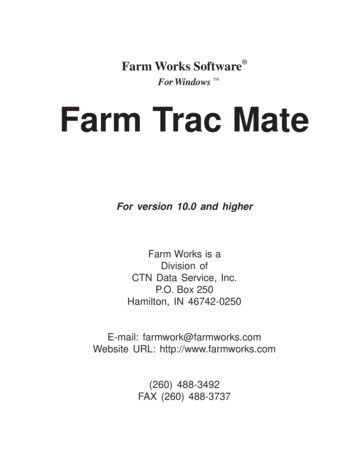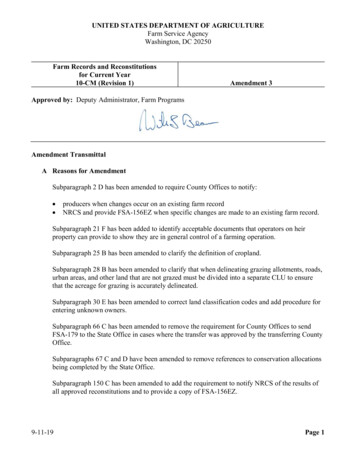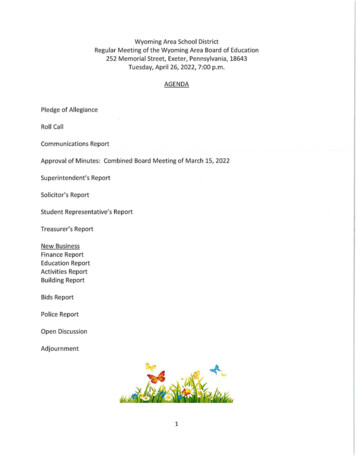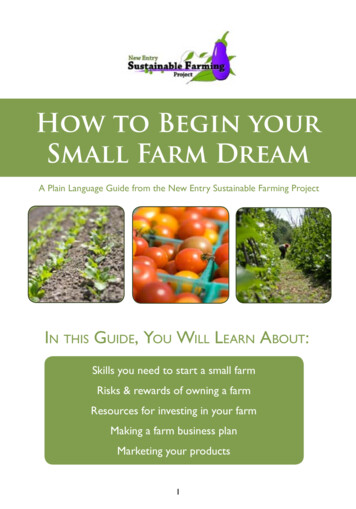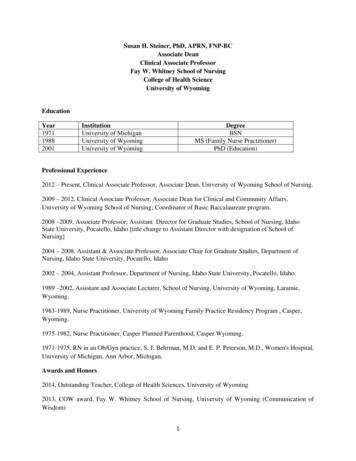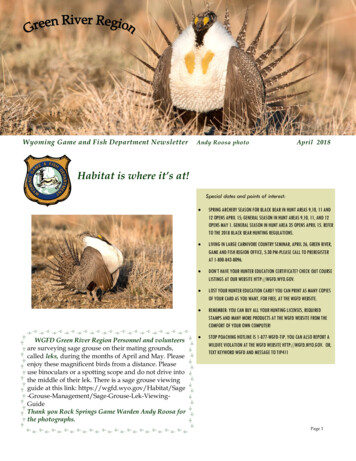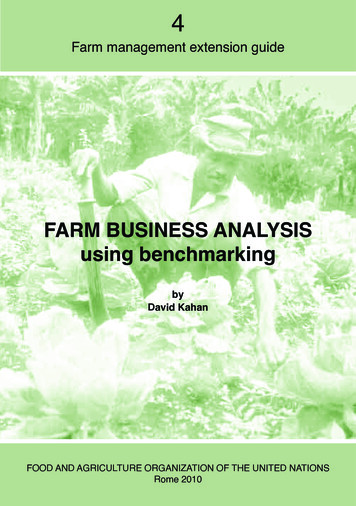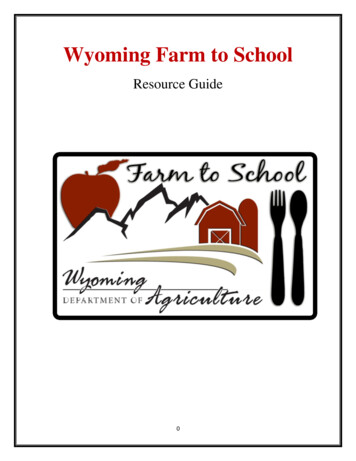
Transcription
Wyoming Farm to SchoolResource Guide0
Table of ContentsIntroduction . 2What Is Farm to School . 3Why Farm to School . 3Farm to School for Wyoming Schools Handout . 4Section 1: Resources for Schools. 6Finding Local Foods . 6Geographical Preference Price Points . 6Meat Processing Plants . 6Wyoming State Inspected Meat Plants Map . 7Wyoming Meat Inspection Program Handout . 8Farmers Markets . 10Seasonality . 10Using Local Foods . 10Recipes . 10Salad Bars . 11School Food Safety . 11Staff Training . 12National School Food Programs . 12Educational Resources for Schools . 12Curriculum . 13Projects and Activities. 14Farm Field Trips. 14Wyoming Agricultural Commodity Map . 15School Gardens . 16Starting a School Garden . 16School Garden Legal and Safety Considerations . 16Additional School Garden Resources . 17Farm to School for Wyoming Producers Handout . 18Section 2: Resources for Producers . 20Selling to Schools . 20Meat Processing Plant . 20Producer Food Safety . 21Season Extension . 21High Tunnels . 21Section 3: More Resources. 22Wyoming Resources . 22National Resources . 23State Farm to School Programs . 241
IntroductionThe purpose of this guide is to connect Wyoming schools, producers and other interested participantswith resources for building successful Farm to School programs.Farm to School programs bring nutritious, locally produced foods to school children and communitiesnationwide. The programs provide the opportunities to teach students about where food comes from,who grows it and instill lifelong healthy eating habits. Use of local produce in cafeterias also gives localproducers a new direct market and mitigates the effects of transporting food long distances.The Farm to School network endeavors to support community based food systems, strengthen familyfarms, reduce childhood obesity and improve student nutrition habits. The Farm to School program canextend far beyond using local foods in the cafeteria to include waste management programs likecomposting, hands-on educational opportunities such as planting school gardens, cookingdemonstrations and farm field-trips. Farm to School not only aids children in gaining agricultural andnutritional knowledge, but also benefits local producers and helps foster a stronger community.Farm to School ContactsWyoming Department of AgricultureWebsite: agriculture.wy.govBrook BrockmanPhone: 307-777-5612Email: brook.brockman@wyo.govTed CraigPhone: 307-777-6651Email: ted.craig@wyo.govConsumer Health Services DivisionWebpage: agriculture.wy.gov/divisions/chsDean FinkenbinderPhone: 307-777-6587Email: dean.finkenbinder@wyo.govLinda StrattonPhone: 307-777-6592Email: linda.stratton@wyo.govWyoming Business CouncilWebsite: www.wyomingbusiness.orgKim PorterPhone: 307-777-6319Email: kim.porter@wyo.govWyoming Department of EducationContact Us webpage: edu.wyoming.gov/ContactUs.aspxTerry WallingPhone: 307-777-6270Email: terry.walling@wyo.govNational Farm to School NetworkContact Us webpage: www.farmtoschool.org/contact.php2
What is Farm to School?Farm to School is a broad term used to describe efforts to connect healthy local foods and agriculturewith schools, students and other institutions.The goal of the Wyoming Farm to School Program is to support healthy children, schools, farms andcommunities by utilizing local agriculture.Farm to School programs are based on the premise that students will choose healthier foods, includingmore fruits and vegetables, if products are fresh, locally grown and picked at the peak of their flavorand if those choices are reinforced with educational activities.All Child Nutrition Programs can participate in the Farm to School Program including: The National School Breakfast and Lunch Program The Fresh Fruit and Vegetable Program The Summer Food Program The Child and Adult Care Food ProgramKey components of the Wyoming Farm to School program include: Fresh, locally grown and produced products served in school meals and snacks Educating students about nutrition and agriculture School gardens Producer visit and farm/ranch toursWhy Farm to School?Farm to School projects provide benefits to the entire community: children, producers, food servicestaff, parents and teachers. Enhance students' educational experience and cultivate long-term healthy eating habits. Open new markets and increase revenues and customer base for farmers.Develop community support and awareness about local food systems.Open opportunities to make a positive difference in the lives of Wyoming school children.Strengthen community relationships.Increase knowledge of where food comes from and who grows it.Support family agricultural production, which is facing the greatest decline of all occupations in theU.S.Use school gardens to teach students the connection between growing plants and eating healthyfoods.Combat childhood obesity.Reduce the number of miles food travels from producer to plate. The average distance food travelsis 1,500 to 2,400 miles. 3
Farm to School for Wyoming SchoolsWhat is Farm to School?Farm to School connects schools and local producers with the objectives of: Serving healthy meals in school cafeterias Providing agriculture, health and nutrition education opportunities Supporting local producers Fostering the knowledge of where food comes from and who grows it.o National Farm to School Website: www.farmtoschool.orgo Wyoming Farm to School Farm to School.aspxo USDA Know Your Farmer Know Your Food:www.usda.gov/wps/portal/usda/usdahome?navid KNOWYOURFARMERThere are many ways to become a farm to school purchaser. The details of the school’s Farm to Schoolprogram will have to fit the specific requirements and procedures of the school and will vary with theproducers involved, however there are some common aspects to be considered Food SafetyNational and state food safety regulations are applicable at every school. Schools may have additionalregulations and procedures dependent on the kind of product being purchased and served. Theseadditional resources may be helpful: The Wyoming Department of Agriculture Consumer Health Services oversees food safety in WY:agriculture.wy.gov/divisions/chs GAP (Good Agricultural Practices) and GHP (Good Handling Practices) provide principles for safeproduction and handling processes.o The USDA Grading, Certification and Verification webpage includes GAP and GHP ta.do?template TemplateN&page GAPGHPAuditVerificationProgram ServeSafe presents training information and programs for food safety practices: www.servsafe.com The USDA Farm to School, Food Safety Page addresses aspects of food safety in farm to schoolprograms: asonalitySeasonality can create challenges when buying local produce. The availability of farm products changeswith the seasons and, at times, typical menu items may not be grown locally. Creativity and flexibilityare important in this area. Salad bars, processing, pick-of-the-month programs and in-season substitutesare a few of the possibilities for addressing seasonal challenges. The National Farm to School Network presents ideas in this publication on how to approachseasonality: www.farmtoschool.org/files/publications 349.pdfTips for Schools Meat processed in Wyoming state inspected plants may be purchased by any licensed establishment(including schools) within the state of Wyoming. Contact the Wyoming Department of AgricultureConsumer Health Services with questions or concerns: agriculture.wy.gov/divisions/chs4
The USDA Farm to School page has resources for student education, school gardens, staff trainingand more: www.fns.usda.gov/cnd/f2s/f2s-resources.htmFinding Fresh Produce The Fresh Fruit and Vegetable Program (FFVP) is administered nationally by the U.S. Department ofAgriculture’s Food and Nutrition Service and in Wyoming by the State Department of Education. Theprogram seeks to increase school access to fresh fruits and vegetables.o The USDA FFVP Page: www.fns.usda.gov/cnd/ffvp/o The Wyoming Department of Education FFVP page:edu.wyoming.gov/Programs/nutrition/fresh fruit and vegetable program.aspxThe DoD Fresh Fruit and Vegetable Program (DoD Fresh) is sponsored by the Department ofDefense. The program works to bring schools a greater variety of fresh produce.o The USDA DoD Fresh page: rs markets are a source of fresh and locally grown products.o Listing of farmers markets in Wyoming:www.wyomingfarmersmarkets.org/List of WY Farmers Markets.pdfo The Wyoming Business Council’s farmers market ts/1302Geographical Preference Price Points are used to help schools purchase locally produced foods.o The USDA explains applying Geographical Preference in this Q &A mos/2011/SP18-2011 os.pdfThe University of Wyoming Extension’s Eat Wyoming website provides a local food database /index.aspMake Your ContactWorking one-on-one with a producer provides opportunities for arrangements to be tailored to theneeds of both parties involved. Form a clear understanding of the producer’s needs and policies.Flexibility can help build strong business relationships. Here are some questions to consider: Product Informationo Which products types and volume are produced?o What time of year and how often are products available?o How much advance notice can the producer give of available product?o What is the price per unit? Food Safety & Liabilityo What kind of storage is necessary to keep products fresh and in good condition?o What food safety plans/procedures does the producer have in place?o Does the producer carry liability insurance? Other Considerationso What transportation and delivery options can be arranged?o What methods of communication are mutually agreeable?5
Section 1: Resources for SchoolsFinding Local FoodsPerhaps the most challenging aspect of implementing a Farm to School program is sourcing local foods.There are many ways to find and take delivery of local products. Whichever methods are chosen, theyshould meet the needs of both your school food service and the local producers involved in order to besustainable over the long term.The Wyoming Department of Agriculture can assist you in finding and contacting local producers.2219 Carey AvenueCheyenne, WY 82002-0100(307) 777-7321(307) 777-6593 (FAX)Email: wda1@wyo.govWebsite: agriculture.wy.gov UW Extension; Eat Wyoming, local food database and dex.aspThe USDA Farm to School FNS Policy webpage provides food procurement information and mColorado Farm to School; Colorado Glossary of School Food & Farm to School Procurement aXVnSU0/editGeographical Preference Price PointsChild Nutrition Programs can apply a geographic preference (state, county and/or region) whenprocuring unprocessed locally grown and locally raised agricultural products. The USDA explains applying Geographical Preference in this Q &A licy-Memos/2011/SP18-2011 os.pdfThis National Farm to School Network publication answers questions about how to applyGeographic Preference : www.farmtoschool.org/files/publications 365.pdfMeat Processing PlantsMeat processed in Wyoming state inspected plants may be purchased by any licensed establishment(including schools) within the state of Wyoming. Contact the Wyoming Department of Agriculture Consumer Health Services with questions orconcerns. WDA CHS webpage: http://agriculture.wy.gov/divisions/chsThe WDA Wyoming Meat Inspection Program handout (pg. 8-9) provides state inspected meat plantcontact information.The Wyoming State Inspected Meat Plants map (pg.7) shows Wyoming meat plant names andlocations.6
ocations7
WYOMING MEAT INSPECTION PROGRAMFebruary 2012 presentation to FSA ProgramThere are 20 state inspected meat plant and 28 custom exempt plants in Wyoming. The meatplants are broken down into 3 categories; state inspected, custom exempt and wild game.Wyoming Department of Agriculture Consumer Health Services (CHS) inspectors inspect thestate meat plants every time the slaughter and processing of animals occurs. The inspectorreviews the slaughter process of all animals from the time they are received at the plant to thetime the carcass is placed in the cooler. The meat processed in a state inspected plant can be soldto any licensed establishment. These include stores, restaurants and institutions such as schools,hospitals, prisons or individuals within the state of Wyoming but cannot be sold out of state.CHS inspectors are in the state inspected meat plants during all slaughter and processingprocedures. In some instances, this requires the CHS inspector to be in the plant on a dailybasis. The state inspected plants are considered by USDA to have an “equal to status”. Wyomingreceives grants to operate their meat program from USDA. Therefore, the Wyoming Departmentof Agriculture Consumer Health Services Division is audited every three years and yearly a selfassessment is submitted to USDA to maintain its “equal to status”. This allows state meat plantsto apply the Wyoming mark of inspection to meat products.8
The custom exempt meat plants slaughter animals and process the meat for the individualowner. Meat processed in a custom exempt plant cannot be sold to establishments or otherindividuals. Some state and custom meat plants will purchase meat from a federal or stateinspected plant then further process the meat and then can sell it to other establishments orindividuals.USDA has an exemption from inspection for HRI (hotel, restaurant and institution) that a customplant can process under. But there are restrictions they are as follows: There must be a valid retail meat sales business at the establishment HRI under this exemption is only for raw meat products Under the retail exemption regulations, sales to HRI have two maximum limits: 25 % orthe dollar value of total product sales, or the calendar year dollar limitations. The USDAsets the dollar limits according to the consumer index: for 2011 it was 61,900 for meatand 50, 200 for poultry. If an establishment goes over these limits they must come under inspection. In Wyoming a custom exempt plant is probably not feasible due to low volume retailsales. They can easily exceed the exemption requirements by selling meat under HRI.Wyoming state inspected meat plants do different processes. Some only do slaughter, processingor combination of slaughter and processing. There are areas of the state where there are not statemeat plants within several hundred miles.The state meat plants in 2011 did the following in volume:Beef slaughtered – 2662 headRaw product such as steaks and roasts – 651,463 lbs.Raw ground product this is mainly beef – 595,318 lbs.Raw fresh sausage – 79,618 lbs.Wyoming Department of Agriculture Consumer Health Services DivisionWebpage: agriculture.wy.gov/divisions/chsDean FinkenbinderPhone: 307-777-6587Email: dean.finkenbinder@wyo.govLinda StrattonPhone: 307-777-6592Email: linda.stratton@wyo.gov9
Farmers MarketsFarmers markets are a source of fresh and locally grown products. Listing of farmers markets in Wyoming:www.wyomingfarmersmarkets.org/List of WY Farmers Markets.pdfThe Wyoming Business Council’s farmers market rkets/1302The Wyoming Farmers Marketing Association works to promote WY farmers markets and local foodproducers: y can create challenges when buying local produce. The availability of fresh products changeswith the seasons and, at times, typical menu items may not be grown locally. Creativity and flexibilityare important in this area. Salad bars, processing, pick-of-the-month programs and in-season substitutesare a few of the possibilities for addressing seasonal challenges. The National Farm to School Network presents ideas in this publication on how to approachseasonality: www.farmtoschool.org/files/publications 349.pdfUsing Local FoodsThe freshness and nutritional value of local foods can help cultivate long-term healthy eating habitsin students. Offering locally grown foods in your cafeteria also gives you a chance to use food as ateaching tool. It can help students understand where their food comes from and who grows it. USDA presents a guide to buying and serving locally grown produce in school meals:www.ams.usda.gov/AMSv1.0/getfile?dDocName STELDEV3101426Vermont FEED, A Guide for Using Local Foods in Schools:food-hub.org/files/resources/FEED LocalPurchasingManualFINAL.pdfFood Research and Action Center (FRAC); Using Local Foods in Afterschool and Summer NutritionPrograms, Fresh from the Farm: eguide.pdfRecipesMenu planning with local foods can be a challenge. Here are some resources that may be helpful. The Lunch Box is an online school food toolkit, including recipes and a searchable food database:www.thelunchbox.orgOklahoma Farm to School; Kidchen Expedition, Online husetts Farm to School Cookbook, Fresh From the Farm:www.mass.gov/agr/markets/Farm to school/docs/farm to school cookbook.pdfNew Hampshire, Fruit and Veggie Quantity ok.pdf10
Vermont FEED, Healthy Snacks recipes: ew Jersey Farm to School recipes /Minnesota Farm to School; A Collection of Simple Scratch Recipes Served in Minnesota pdfs/NowCooking.August22.pdfUnits/Conversion Kansas Farm to School; Volumes and Conversions, How Do You “Measure Up”?:www.kn-eat.org/F2S/F2S Docs/Guidance/Volume Conversion Chart.pdf Kansas Farm to School; Weights and Approx. Processed Yields:www.kneat.org/F2S/F2S Docs/Guidance/Weights and Approx Processed Yields Common Fruits Veggies.pdfSalad BarsSalad bars are a good way to introduce local foods and encourage students to make healthy fooddecisions.The Let’s Move’s Salad Bars to School Program offers salad bar grant opportunities for schools. Let’s Move Salad Bars to School website: saladbars2schools.org Let’s Move Salad Bars to School’s publication explains their program and the importance of saladbars in schools: mofarmtoschool.missouri.edu/foodservice/why salad bars.pdfFood SafetyFood safety is a priority for schools and local producers. National and state food safety regulations areapplicable at every school. Other regulations and procedures may be dependent on the school and typeof product. The Wyoming Department of Agriculture Consumer Health Services oversees food safety in WY:agriculture.wy.gov/divisions/chsThis USDA publication gives recommendation for handling fresh produce in schools:www.fns.usda.gov/fns/safety/pdf/best practices.pdfGAP (Good Agricultural Practices) and GHP (Good Handling Practices) provide principles for safeproduction and handling processes. The USDA Grading, Certification and Verification webpage includes GAP and GHP lateData.do?template TemplateN&page GAPGHPAuditVerificationProgram11
Staff Training ResourcesTraining staff members in food safety practices is an important part of ensuring food safety. The USDA webpage addressing food safety aspects (including staff training) in Farm to Schoolprograms: rveSafe presents training information and programs for food safety practices:www.servsafe.com/homeNational School Food ProgramsThe following programs work to promote healthy school foods and may be helpful in fostering a Farm toSchool program. The USDA School Meals Regulations webpage provides the rules and regulations for USDA schoolfood ns.htmThe DoD Fresh Fruit and Vegetable Program (DoD Fresh) is sponsored by the Department of Defense.The program works to bring schools a greater variety of fresh produce. USDA DoD Fresh htm Community Food Security Coalition publication on DoD Fresh Program frequently asked questions:www.foodsecurity.org/dod f2s.pdfThe USDA Fresh Fruit and Vegetable Program (FFVP) is administered nationally by the U.S. Departmentof Agriculture’s Food and Nutrition Service and in Wyoming by the State Department of Education. Theprogram seeks to increase school access to fresh fruits and vegetables. USDA FFVP webpage:www.fns.usda.gov/cnd/ffvp/ Wyoming Department of Education FFVP webpage:edu.wyoming.gov/Programs/nutrition/fresh fruit and vegetable program.aspxEducational Resources for SchoolsFarm to School programs provide excellent educational opportunities. Students gain increasedknowledge of nutrition, healthy eating, local foods, agriculture and the environment. There are manytools available to assist you. The Agriculture in the Classroom program seeks to improve agricultural literacy in schools.o National Agriculture in the Classroom website:www.agclassroom.org/index.cfmo Wyoming Agriculture in the Classroom website:www.wyomingagclassroom.org12
CurriculumThese curriculum resources present materials for everything from specific Farm to School lessons tobasic nutrition and agricultural education. Junior Master Gardener seeks to enhance the learning process through gardening education:jmgkids.us Midwest Farm to School Network; Farm to School Lessons and Curricular Resource Links:www.agri.ohio.gov/public %20Resource%20Links.pdf Sustainable Agriculture Research & Education (SARE); Sustainable Agriculture Resources andPrograms for K-12 Youth, webpage: -K-12-Youth The Food Project; Sustainable Agriculture Curriculum -curriculum Kentucky Farm to School; 9th-12th Grade armtoSchoolCurriculum.pdf South Carolina Farm to School Educational Resources webpage:scfarmtoschool.com Georgia Farm to School Lesson Plans achers/samplefarmtoschoollessonplans.aspx Farm to Preschool: Curriculum; Powerpoint:www.agri.ohio.gov/public ums.pdf Food, Land & People (FLP); Resources for Learning webpage:www.foodlandpeople.orgGranny’s Garden School; Learning Resources webpage:www.grannysgardenschool.comCooking with Kids Inc.; Curriculum webpage:cookingwithkids.net/store/curriculum/Team Nutrition is a USDA program that promotes childhood health and education through communityinvolvement and improved school meals. Team Nutrition website: www.fns.usda.gov/tn/Default.htm Resource Library webpage: teamnutrition.usda.gov/Resources/growit.html Preschool Fun with Fruits and Vegetables, Grow It, Try It, Like It! Books:o Book 1- The Basics: teamnutrition.usda.gov/Resources/growit book1.pdfo Book 2- Crookneck Squash Row: teamnutrition.usda.gov/Resources/growit book2.pdfo Book 3- Spinach Lane: teamnutrition.usda.gov/Resources/growit book3.pdfo Book 4- Sweet Potato Hill: teamnutrition.usda.gov/Resources/growit book4.pdfo Book 5- Cantaloupe Corner: teamnutrition.usda.gov/Resources/growit book5.pdfo Book 6- Peach Tree Orchard: teamnutrition.usda.gov/Resources/growit book6.pdf13
o Book 7- Strawberry Patch: teamnutrition.usda.gov/Resources/growit book7.pdfFood and Nutrition Fun for Preschoolers; Resource List:teamnutrition.usda.gov/Resources/growit fun.pdfProjects and ActivitiesHands-on projects and fun activities are another good way for children to learn. The Wyoming commodity map for kids (pg. 15) Vermont FEED; guide to Taste Testing New Foods in the Classroom and Cafeteria, w-foods.pdf Missouri Farm to School; Activity Worksheets, Resources for School Staff sources.htmlAlaska Farm to School; class activity instructions, Carrot Seed Tape Activity:dnr.alaska.gov/ag/FarmToSchool/Carrot seed tape.pdfKansas Farm to School; physically interactive activity instructions, Knock Out Snacks Game: www.kneat.org/F2S/F2S Docs/Resources/Knock Out Snacks Game.pdfKansas Farm to School; Cross word puzzle, Producer Power Puzzle: www.kneat.org/F2S/F2S Docs/Resources/Produce Power Puzzle.pdfOklahoma Farm to School Craft activity, Construct a Fun Bean Stalk ConstructABeanStalk.pdf Class activity and worksheets, Plant Parts We lant-Parts-We-Eat.pdf Physically interactive activities, Play with Your PlaywithFood.pdf Recipes for Ag Classroom recipes.pdfFarm Field TripsField trips are an excellent way of showing students where food comes from and who grows it. Appalachian Sustainable Agriculture Project; Guide to Farm Field Tr
National Resources. 23 State Farm to School Programs. 24 . 2 Introduction The purpose of this guide is to connect Wyoming schools, producers and other interested participants with resources for building successful Farm to School programs. Farm to School programs bring nutritious, locally produced foods to school children and communities .
